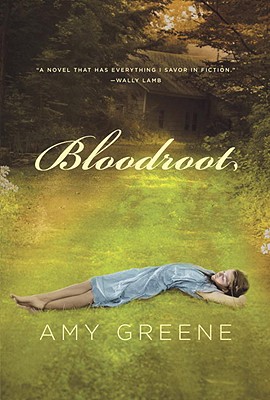To spend a couple hours with Bloodroot (Alfred A. Knopf, 2010) by Amy Greene, is to descend into a world both wildly beautiful and brutally violent.
Greene, who, according to her bio, “was born and raised in the foothills of East Tennessee’s Smoky Mountains,” calls on the people and landscapes with which she’s most familiar. Bloodroot takes its name from Bloodroot Mountain where the Lamb family — who the book follows for four generations — calls home. The book revolves mainly around the Lamb women and the men who come into their lives, beginning with grandmother Byrdie. Byrdie survives the Great Depression, raising a family and building a life with her husband. But Byrdie’s daughter Clio is lured away from the shelter of Bloodroot Mountain, called by the siren song of the nearby town and a man who treats her badly. Byrdie is left to raise Clio’s daughter, a free spirit named Myra who shows little interest in men or the world beyond the mountain — that is until she meets rakish John Odom.
Greene writes her characters in dialect (“Don’t get wrought up. We’ll worry about getting shed of it later.”) and, at first, this bothered me as a reader. Dialect can be difficult to pull off; sometimes it’s painful and embarrassing, sometimes distracting. Greene handles this delicate matter with much diplomacy, carefully choosing which words to write in mountain speak and never comes close to hillbilly cliche territory.
In fact, so seamless is Greene’s handling of speech patterns that soon the dialog reads effortlessly and the character’s voices offer up a clear telling of their hopes and fears. The stories are bleak — the Lamb women tend to leave school early, give up dead end jobs to live in squalor with men who are poorly equipped to be husbands or fathers. Poverty, rough childhoods, little family support, inadequate education, drug abuse and alcoholism all lend themselves to abusive relationships. Children are taken by the state, family members are lost to physical and mental illness.
“If I had gone over I would have taken all of it with me, the things I’ve never spoken of,” Myra realized after nearly falling from a mountain ledge. “How the rabbit’s back legs kicked and went still, how it smells of grave dirt under old houses, how it feels to bring a hatchet blade down on human flesh.”
But even as Greene tells a tale probably all too common in the poorest communities of Appalachia, she also reveals something rarely talked about. Bloodroot is about a strong sense of self, a connection to place and an all-consuming desire for freedom.
Doug, Myra’s neighbor who carries a torch for her, recalls, “I leaned in and pressed my mouth, ever concealing the broken tooth, against hers. But I’m no fool. It was Bloodroot Mountain she tasted when I kissed her lips. I might as well not even have been there. I knew it then and I know it now.”
The generations and decades weave together in Bloodroot, perhaps showing how the Lamb family never really gains a foothold and never makes progress. Or maybe Greene’s non-linear story line illustrates, instead, how people are interconnected like blood wending through veins. And — perhaps like art illustrating life — Greene manages to chase to darkness and sadness of Bloodroot with stunning scenery, tender moments and an unexpected — but welcome — happy ending.
Amy Greene reads at Fireside Books on Friday, Feb. 12, 7 p.m. and at Malaprop’s on Saturday, Feb. 13 at 7 p.m.
—Alli Marshall, A&E reporter





An interview with Amy Greene is here:
A Remedy for Curses: An Interview with Bloodroot Author, Amy Greene
http://www.appalachianhistory.net/2011/06/a-remedy-for-curses-an-interview-with-bloodroot-author-amy-greene.html?utm_source=rss&utm_medium=rss&utm_campaign=a-remedy-for-curses-an-interview-with-bloodroot-author-amy-greene